From the outside, the North Las Vegas Learning Center appears to be just another ordinary office building. But step inside and discover an indoor farm where rows of leafy, vibrant vegetables flourish in vertical towers and tiered metal racks. With the controlled atmosphere, the room feels like an oasis, an escape from the scorching Las Vegas desert.
Inside, Most Tahera Naznin, an associate professor of urban and indoor agriculture at the University of Nevada, Reno's College of Agriculture, Biotechnology & Natural Resources, carefully examines a freshly harvested crop of lettuce. Today, her team has gathered about 300 heads of lettuce and an assortment of culinary herbs. While she sets aside a portion for research, the rest is swiftly transported to a local food bank, providing fresh, nutrient-rich greens to community members at risk of malnutrition.
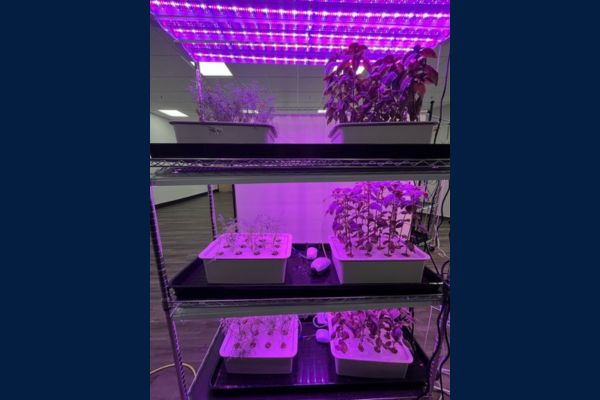
Supporting access to fresh vegetables in the larger Las Vegas area
The Urban Indoor Farm Project was developed by Extension, a unit of the College dedicated to transforming research into practical projects that improve the lives of Nevada communities. The project is part of a global trend in urban farming that is changing how cities with limited agricultural land are addressing food security, environmental sustainability, and economic growth.
"Indoor farming offers a sustainable way to grow fresh vegetables in southern Nevada, especially as the population and demand for fresh food in the Las Vegas area keep increasing," Naznin said. "Through Extension, we're committed to this educational and research project because we believe that with today's agricultural technology, the desert's harsh conditions shouldn't limit access to locally grown produce year-round."
Since launching the indoor farm project two years ago, Naznin, who also conducts research as part of the University's Experiment Station and her team members, including the Experiment Station's Research Scientist Obyedul Azad, have been monitoring every aspect of plant growth and physiological response, tracking temperature, humidity and carbon dioxide levels at each growth stage. Their research aims to identify the ideal conditions for a nutritious, phytonutrient- and antioxidant-rich robust harvest, attracting interest from seasoned farmers and newcomers to indoor farming, such as Laird Sanders and Brian Ward, founders of Predictable Produce, a new indoor farm in Henderson, just 15 miles southeast of Las Vegas.
Providing free training and demonstration in indoor farming techniques
Sanders, an alumnus of the University's College of Business, and his associate Ward are part of a new wave of entrepreneurs aiming to make indoor farming commercially viable in the region. Their business model focuses on cultivating unique culinary herb blends tailored for food connoisseurs. For example, their mild Japanese Mizuna mustard blends add a subtle, exotic twist to salads and soups, without the overpowering bite of a traditional mustard. They also grow a variety of spicy arugula, cabbage, kale, radishes, basil, amaranth and more.
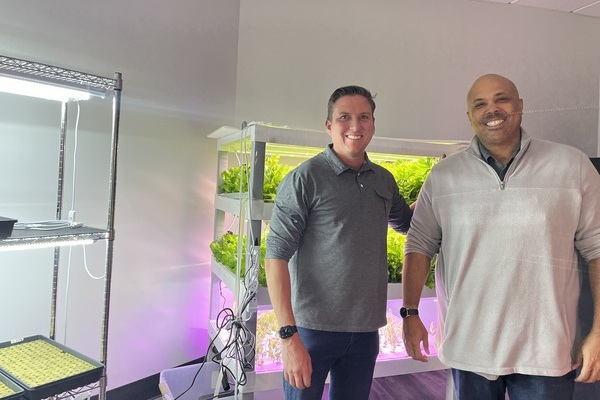 Laird Sanders and Brian Ward are the entrepreneurs behind the Predictable Produce indoor farm in Henderson
Laird Sanders and Brian Ward are the entrepreneurs behind the Predictable Produce indoor farm in Henderson
The business partners have secured weekly supplier contracts with two local restaurants, relying solely on the harvest from their 360-square-foot farm, which, at full capacity, can produce nearly 200 pounds of leafy greens per month.
"We've learned a lot as new indoor farmers this past year, and seeing Naznin's setup and the research behind it has been eye-opening for us," Sanders said. "As we grow our project, Extension's research has given us a clear path to improve the health of our crops while reducing setup and production costs."
With research, hydroponic farmers have adopted the use of LED lighting, which costs almost 40% less than traditional lighting. Further research is looking at diversifying crop production and producing crops that are richer in antioxidants and other health-beneficial food properties, based on Extension's research.
Sanders met Naznin and her team at an urban agriculture conference in Las Vegas hosted by Extension. After their initial meeting, they visited Extension's indoor farm, where Naznin and her team offered invaluable guidance to help boost their crop production.
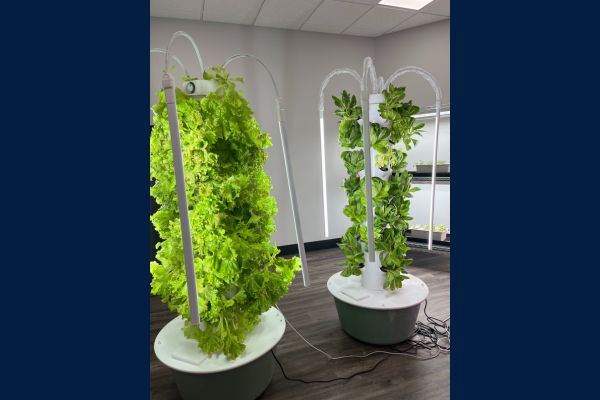
"So far, Extension has taught us creative methods to build our own hydroponic towers from scratch and how to identify and address common issues affecting plant health," Sanders said.
Compared to the high setup costs they initially faced, Sanders and Ward now know they can build hydroponic equipment – used to cultivate vegetables with artificial lighting and nutrient solutions instead of soil – at a fraction of the price. They have also gained valuable insight into the science of controlling key growth factors in a hydroponic indoor farming system and managing plant diseases.
Extension also assisted the entrepreneurs in applying for a competitive U.S. Department of Agriculture grant supporting indoor food production.
"Although we didn't secure the grant this time, we're better positioned for next year and hopeful we'll be able to expand our operations," Sanders said.
Researching different indoor farming techniques
In southern Nevada, where nearly 90% of greens are imported, indoor farming could be a game-changer for food security, boosting local access to fresh, nutritious produce year-round.
Extension's Urban Indoor Farm Project is housed in a 600-square-foot facility equipped with LED lighting systems and technology to monitor room humidity, temperature, and carbon dioxide levels. Each week, Naznin and her team track the size, shape, and health of the plants, and after each harvest, they test the nutrient and antioxidant levels of the crops, storing this data for long-term research. The facility features three hydroponic systems, each with a unique method for delivering nutrient-rich water to plant roots.
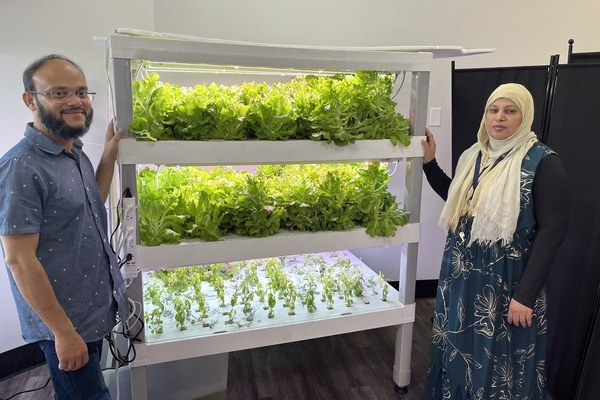 The ebb and flow hydroponic system cycles nutrient-rich water to the plants, providing essential aeration between floods. Naznin and Azad pose for a picture after a demonstration tour.
The ebb and flow hydroponic system cycles nutrient-rich water to the plants, providing essential aeration between floods. Naznin and Azad pose for a picture after a demonstration tour.
The nutrient film technique circulates a thin, continuous stream of nutrients over roots in a vertical tower garden, allowing up to 28 bunches of spinach or kale to grow in just 36 square inches. The ebb and flow system floods and drains a tray, providing roots with aeration between water cycles. Each 4-by-3-foot tray can grow around 108 bunches of vegetables, while three tiers on one rack can grow 324 bunches of vegetables. The deep-water culture system, on the other hand, keeps roots fully submerged in nutrient-rich water, giving them direct access to nutrients, and can hold up to nine heads or bunches of vegetables and herbs in a 2.5-gallon bucket.
Naznin's team is studying how different light particles affect plant growth at each stage. They are also focusing on how to adjust nutrient delivery and fine-tune temperature, humidity, and carbon dioxide levels to improve the plant's health-boosting compounds while reducing the use of light and water, in what a horticulturist might call climate-smart precision indoor farming. Their findings so far suggest that blue light helps with early growth and the production of chlorophyll, a green substance in plants that helps them absorb sunlight for energy. Red and far-red light support flowering and growth at later stages, while green light helps plants make energy and stay healthy.
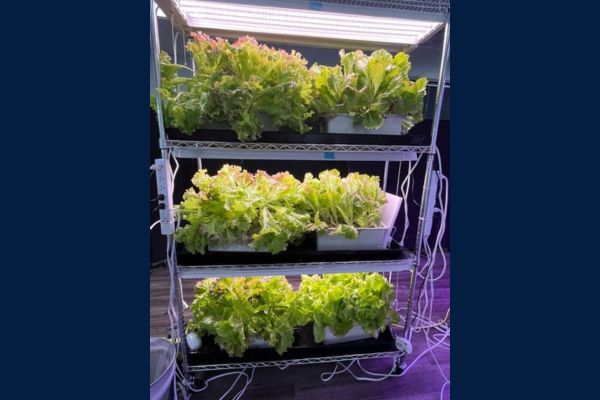
"Part of Extension's role is to translate scientific research into community-driven, life-changing projects, which is why our findings are so crucial," Naznin said. "We're doing the groundwork so that farmers and residents can grow their own vegetables without the costly trial and error, and our goal is to help southern Nevada enhance its food security and self-sufficiency."
Need for government support
One hurdle that Sanders and Ward have been navigating is zoning, as indoor farms don't fit neatly into traditional categories such as agricultural or commercial zones.
"The misunderstanding and misclassification of urban farming can create significant hurdles in gaining governmental approval and support," Sanders said. "Other issues, such as the lack of UL-listed equipment, can also complicate compliance with codes and insurance requirements. Our local governments could benefit from education and engagement to understand the benefits of indoor farming.
In the meantime, Sanders and Ward say they will continue working closely with Extension to expand their crop diversification and refine their farming techniques. They are also focusing on marketing their unique offerings to attract more customers and build a strong, sustainable presence in the local market.
If you are interested in scheduling a tour of Extension Urban Indoor Farm Project, email Naznin or call her at 702-948-5917. Persons in need of special accommodations or assistance should email Paul Lessick, civil rights and compliance coordinator, or call him at 702-257-5577 at least five days prior to the scheduled event with their needs or for more information.
Source: unr.edu
